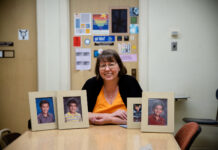Story and photos by Ava Weintraub
Brain surgery couldn’t keep this dedicated teacher away

The diagnosis was dire. The doctors said he had about a week to live and to get his affairs in order.
It was a type of brain tumor called a “schwannoma,” a benign tumor that grows around the sheath of the cranial nerves. But this was a big one – the tumor had grown so large it displaced parts of his brain. After trips to several neurosurgeons he was told there was nothing they could do.
That was July 6, 2011.
Dr. Leland (Lee) Shapiro has been teaching agricultural science at Pierce College for more than 40 years.
Lee had his brain operation on July 19, 2011. The successful eight-hour operation involved removing tumors that encased several cranial nerves.
After two months, Lee returned to Pierce determined to teach his classes.
“I was afraid that my students would be impacted by my absence.” Lee says. “I am so very fortunate in that I have the hardest working, most compassionate students of any faculty member.”
One student he didn’t want to let down was 28-year-old retired Marine Sergeant William Melendez.
William, a pre-veterinary major, was deployed three times, the first two were to Iraq and the last to Afghanistan, during his studies at Pierce.
“I never had a close father figure and in many ways Dr. Shapiro is like a father to me,” William says.
Lee told William to be careful and to return to his studies. When he did, William gave Lee a flag that had flown over his base in Fallujah, Iraq. It is prominently displayed in his office over his desk.
“He is a remarkable young man. He put his studies on hold so he could fight for our country,” Lee says. “[My students] make my job easy. “
Lee was born in 1953 and is the grandson of four immigrants who came to America from Eastern Europe. Lee’s maternal grandfather settled in Los Angeles and was a farm laborer near 92nd Street in Watts in 1907.
It was all farmland then. “My mother grew up in Watts and my dad in East Los Angeles. My grandfather talked about working on the farms, milking the cows, etc,” Lee says.
The third generation Angeleno followed his father to West Africa in 1967 to teach Nigerians a way of living during the Nigerian Civil War when he was 14 years old. Lee was kicked out of the country when he hid three members of a family from the Republic of Biafra from the Nigerian army in his house. He returned to the United States in 1970.
The first cow he milked was at an Adhor Dairy, a small 30-cow dairy, on La Cienega Boulevard and 3rd Street, what is now Cedars-Sinai Medical Center, where Lee would eventually have his brain operation in July 2011.
Before becoming a teacher, Lee was a student at Pierce, after graduating from Chatsworth High School. He worked in the dairy milking cows before his classes started in the morning in 1971.
He left Pierce in 1973 to attend California State Polytechnic University, San Luis Obispo and received a Bachelor of Science in dairy science with a minor in biology. He continued his studies and earned a doctorate in reproductive physiology of cattle from Oregon State University.
“My major emphasis of study has been cows. They are my favorite animal,” Lee says. “They call me Dr. Cows.”
His love for cows would eventually save his life. A colleague from the past would now figure into his future.
A neighbor suggested that he contact Dr. Keith Black, chairman of the neurosurgery department and director of the Maxine Dunitz Neurosurgical Institute at Cedars-Sinai. The doctor is one of a few neurosurgeons in the country that specializes in this delicate surgery.
He contacted the neurosurgeon’s office and was told there was a two-month wait.
“I didn’t have two months,” Lee says.
Lee remembered he knew someone in the veterinary department at Cedars-Sinai. He contacted his colleague and asked if he would contact Keith Black and explain his situation. The doctor agreed to see Lee immediately.
It wasn’t just his students he was thinking about when he decided to return to work early, he is also responsible for organizing an annual gift drive for impoverished children on Indian reservations.
Lee began working with the Walking Shield American Indian Society in 1987. He helped support their annual holiday backpack drive providing clothes, school supplies and toys to underprivileged Indian children. He brought the Pre-Veterinary Club into the process to help with the collection as a way of teaching his students compassion for others.
“The children receiving the gifts are so grateful, it makes a big difference in their lives,” Dr. John Castillo, Walking Shield executive director says. “Dr. Shapiro has been and continues to be an incredible source of support for our charity.”
Each year a different Indian Reservation is chosen and Lee is able to provide Walking Shield with approximately 300 backpacks.
Assistant Professor of Child Development Traci Drelen works with Lee gathering backpacks for the pre-school children every year and is happy to help in the effort.
“Dr. Shapiro is amazing. Each year he is able to gather enough backpacks through a combination of persistence and charm. This year was especially difficult because of the bad economy and Dr. Shapiro’s brain operation,” Traci says. “Despite his operation and his short recovery period he made sure the backpack program didn’t falter.”
Although doing so many things for others, Lee doesn’t consider himself a hero. His heroes are his father, Murray, who served in the Battle of Normandy and taught high school in Los Angeles for 47 years, and William Melendez.
“They’re the real heroes. They put their lives on the line to defend our country,” says Lee.
Despite his feelings, Lee is a hero to many. He doesn’t do things to bring attention to himself; he does things because they are the right things to do, regardless of the outcome.
Lee still suffers from side effects, including fatigue, headaches and swallowing problems but he improves daily. During a recent MRI he learned that the tumor had not returned.
He keeps a copy of his first brain MRI on his iPhone as a reminder of how far he’s come in such a short amount of time. His daily visits to the Farm and seeing his students make it all worthwhile.


